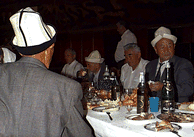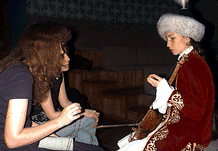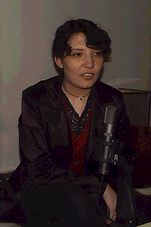Posts Tagged drummer
Day 27 – Two Weddings and a Satellite
Posted by Musical Nomad in Daily Blog on August 24, 1997
 We have set up the satellite in many strange places – it is surprising the number of times we have managed to get a clear view of the Indian Ocean receiver without venturing beyond the nearest road. Sadly there have been too many times when mountains, trees or Soviet apartment blocks have got in the way. Today we had to go somewhere. In a children’s playground in the suburbs of Biskek, Kyrgyzstan, English Nomads could be seen setting up a bizarre array of equipment – morning entertainment for the youngsters. The sound of a motor generator and sight of a ‘sputnik’ in the middle of their playground was too much to resist. After some confused policemen had left us a throng of children gathered and cheered us on as we connected to the world. No big flashing lights or music just Gary saying ‘great – another one off’. We asked them to return at 10 PM for part two.
We have set up the satellite in many strange places – it is surprising the number of times we have managed to get a clear view of the Indian Ocean receiver without venturing beyond the nearest road. Sadly there have been too many times when mountains, trees or Soviet apartment blocks have got in the way. Today we had to go somewhere. In a children’s playground in the suburbs of Biskek, Kyrgyzstan, English Nomads could be seen setting up a bizarre array of equipment – morning entertainment for the youngsters. The sound of a motor generator and sight of a ‘sputnik’ in the middle of their playground was too much to resist. After some confused policemen had left us a throng of children gathered and cheered us on as we connected to the world. No big flashing lights or music just Gary saying ‘great – another one off’. We asked them to return at 10 PM for part two.
 I had the opportunity to spend a late Sunday afternoon walking through Biskek with our new Kyrgyz translator Gulnaz Abdrahmanova. It has been 42 degrees for the last few weeks. Now, after a sudden rain, the weather is typically British and a welcome change for the team. One of the first things that strikes me is the people – they are, like in Almaty, dressed in ‘modern’ clothes, very different from the traditional Muslims of the Fergana Valley of two days ago. The city itself is wide, open and filled with Soviet style buildings and monuments. As we walked through Dubovy park filled with decaying carvings, Gulnaz explained how Biskek had bought up many Russian artifacts from other ex-Soviet countries – they were quite keen to pass them on! Biskek is the most ‘Russian’ city we have visited. It is the only ex-CIS city with a statue of Lenin still dominating it’s main square. It is difficult to know how most of the city react to these relics. Will Lenin last much longer? The people do seem proud of some of thier monuments, especially Urkuya Saliyevas a reformer from Osh who led the Kyrgyz female movement after the revolution.
I had the opportunity to spend a late Sunday afternoon walking through Biskek with our new Kyrgyz translator Gulnaz Abdrahmanova. It has been 42 degrees for the last few weeks. Now, after a sudden rain, the weather is typically British and a welcome change for the team. One of the first things that strikes me is the people – they are, like in Almaty, dressed in ‘modern’ clothes, very different from the traditional Muslims of the Fergana Valley of two days ago. The city itself is wide, open and filled with Soviet style buildings and monuments. As we walked through Dubovy park filled with decaying carvings, Gulnaz explained how Biskek had bought up many Russian artifacts from other ex-Soviet countries – they were quite keen to pass them on! Biskek is the most ‘Russian’ city we have visited. It is the only ex-CIS city with a statue of Lenin still dominating it’s main square. It is difficult to know how most of the city react to these relics. Will Lenin last much longer? The people do seem proud of some of thier monuments, especially Urkuya Saliyevas a reformer from Osh who led the Kyrgyz female movement after the revolution.

Along the main street there is the familiar mix of subway markets, karaoke cafes and photographer stalls. There are eccentric props used by the photographers including large white gorillas, dead birds in a palm trees and broken down cars. One street stall that caused the team much surprise was an evil spirit removal and fortune telling service. A man in jeans and green shirt waved his arms and hissed Shaman-like chants around each customer. A queue of women sat in the open as each were treated in turn. Our presence caused some embarrassment but we were told this service is very much in demand. Gulnaz’s husband goes once a year and she told me how valuable it was to him. I found it so strange to see this kind of thing performed so openly and I thought how much it differed from our meeting with Shaykh Kushkarov on day 20.
The musician, Kurmangazy Aiylchievich who we are going to meet tomorrow, is larger than life. There is something about him that reminds me of Shoberdy – the Baysun Bakshy [see Day16]. He is a wild, flamboyant virtuosic vodka drinker. Unlike Shoberdy he talks extravagantly about musical healing, Shamans and holistic principles but also plays popular hits at public functions.

By reputation Kurmangazy is Kyrgyzstan’s top musician. I’ve been invited by Kurmangazy to a special location. A double celebration of a 70th birthday and a 50th wedding anniversary. As I climb the staircase of the ‘Kyrgyz National Restaurant’, I’m immediately struck by a sea of hats – the white Alpine-like national hat of the Kyrgyz nomads. The old women all wear head scarves softening their sun-gold faces, few smile, their heads filled with memories?

The details vary but I’m sure these occasions have common ground the world over. Solemn vodka laced speeches about ‘fifty happy years,’ on a stage decorated with bouquets and fruit. Children reluctantly pushed to the front, perform party pieces – this time on the national instrument, the komuz. A special delicacy is presented to table – today it’s horse meat – another nomad symbol? Perhaps amongst the gossip there is nostalgia for a Soviet era of greater prosperity and a more certain infrastructure. Nostalgia tempered now by an influx of jobs in fizzy soft drink factories and the fluorescent appeal of catalogue fashions – it’s Sunday and everybody looks their best. In the key of slightly Eb auntie Flo will sing a song: ‘Her mother should know’ – the band struggles to follow.
 Special occasions need special music and Kurmangazy seemed happy to provide the crowd-pleasers. To European ears his band is a bizarre cocktail of popular Kyrgyz melodies, South American music, Jazz and Classical pops. His band are all accomplished conservatoire-trained musicians and appear very relaxed.
Special occasions need special music and Kurmangazy seemed happy to provide the crowd-pleasers. To European ears his band is a bizarre cocktail of popular Kyrgyz melodies, South American music, Jazz and Classical pops. His band are all accomplished conservatoire-trained musicians and appear very relaxed.
 Kurmangazy fronts the band with a frantic energy, swapping frequently between his many wind instruments. The band’s funked-up versions of everything receive a somewhat cool response from the audience of over 50s. The medley of ‘Classic’ hits which Kurmangazy dedicated to us included snippets of Bach, Mozart and Paganini, all arranged in a ‘hooked-on-Classics’ style with a synthesised back-beat. He invited us to attend a healing session he will conduct at midnight!
Kurmangazy fronts the band with a frantic energy, swapping frequently between his many wind instruments. The band’s funked-up versions of everything receive a somewhat cool response from the audience of over 50s. The medley of ‘Classic’ hits which Kurmangazy dedicated to us included snippets of Bach, Mozart and Paganini, all arranged in a ‘hooked-on-Classics’ style with a synthesised back-beat. He invited us to attend a healing session he will conduct at midnight!
Once again the team have to extricate themselves from a tricky situation. We are invited to stay and drink endless vodkas and eat horse with the band. Horse intestines are a local delicacy and it testifies to the wealth of the host that it was in plentiful supply. We were told each horse makes four plates of ‘delicacy’ and costs about 1500 USD. We decide to sneak off and send you this transmission.
 Emerging into the street we encounter a traditional wedding in full flight. Two surnai (shawm) players and a drummer play spiralling polyrhythmic music that makes you want to dance. The bride, groom and entourage arrive and a circle dance starts up in the street. Money is pushed into the hands of the dancers. There is a strong link here with the music of Turkey (the Kyrgyz people are a Turkic people) but the surnai is also very similar to the ghaita of Morocco. In France there is a similar double-reed instrument, the bombard. The double headed drum exists worldwide and in France it is known as the tabor. These connections must be well documented, but to see it in real life gives a startling sense of the cultural overlap between Europe and Asia.
Emerging into the street we encounter a traditional wedding in full flight. Two surnai (shawm) players and a drummer play spiralling polyrhythmic music that makes you want to dance. The bride, groom and entourage arrive and a circle dance starts up in the street. Money is pushed into the hands of the dancers. There is a strong link here with the music of Turkey (the Kyrgyz people are a Turkic people) but the surnai is also very similar to the ghaita of Morocco. In France there is a similar double-reed instrument, the bombard. The double headed drum exists worldwide and in France it is known as the tabor. These connections must be well documented, but to see it in real life gives a startling sense of the cultural overlap between Europe and Asia.
Tomorrow we meet the extraordinary Kurmangazy again and hope to discover more about both his music and his research into ancient Kyrgyz culture.
 Raushan is softly spoken and very articulate . She speaks passionately about Kazak music and in particular about the kobuz. She comes from a musical family. Her father, also a musician, always wanted Raushan to play the kobuz. They are from a region near the Aral Sea, which has its own rich musical tradition. Her sisters play flute and oboe, by all accounts outstandingly well. This musicality stretches back for generations.
Raushan is softly spoken and very articulate . She speaks passionately about Kazak music and in particular about the kobuz. She comes from a musical family. Her father, also a musician, always wanted Raushan to play the kobuz. They are from a region near the Aral Sea, which has its own rich musical tradition. Her sisters play flute and oboe, by all accounts outstandingly well. This musicality stretches back for generations. Raushan explained that Korkut wrote many melodies for the kobuz, and is now seen as a classical composer. She performed a piece for us which utilised the metal jingles attached to the instrument. This was a medley of his tunes and is called Abistolgan. This is very ancient music and she often plays it for herself. “It has to be with me always.”
Raushan explained that Korkut wrote many melodies for the kobuz, and is now seen as a classical composer. She performed a piece for us which utilised the metal jingles attached to the instrument. This was a medley of his tunes and is called Abistolgan. This is very ancient music and she often plays it for herself. “It has to be with me always.”
